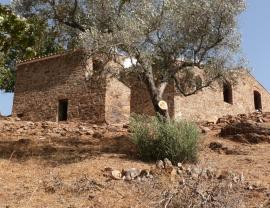Ecosystems and "Dehesa"
A very special characteristic of Sierra de Tentudía and its Dehesas is a great biodiversity, with plenty of different ecosystems: forest, cultivated land, pasture, vegetable garden, Olive land, (olivar) shadowy, sunny hill sides, river side,… Generally speaking vegetation is made up of adapted species to live under dry and warm summers and mild winters, with rains during short periods between spring and autumn.
The climatic dominance or potential vegetation of this area is mediterranean forest or sclerophyllous forest (prevalence of species having leathery, generally small leaves), with species Quercus with perenial and leathery leaves. The predominant vegetation is sclerophyllous, this type of formation is well represented by Holm Oak, Cork Oak, rockrose bushes, “jaguarzo”, “tomillo”, “lentisco”, “retama”, etc.
In this particular area, due to a micro climate (altitude between 600 to over 1,000 m, and proximity to the Atlantic Ocean) the temperature diminishes and the rainfalls increases, typical species from humid areas appear, but in dry summers, it's more Oak, “Quejigo”, all of them “Quercus”.
In some places like river banks and stream beds, with high edafique humidity (nature of soil in relation to plants and surrounding environment), the vegetation is different, finding black poplar, poplar, willow trees. We find as well in the surrounding area Olive, Pine, Chestnut, all kinds of fruit trees like Oranges, Cherries, Quince, Grapevine,…
Landscape:
It is a beautiful natural scenery full of contrasts, Tentudía Massif is the highest peak at 1,104 m, right through Ruta de la Plata. One of the treasures in this natural setting is la Centaurea Tentudaica, a unique flower, endemic and specially protected.
It is a typical mediterranean forested scenery, highlighted by an alternating relief of valleys formed by dehesas and sierras, predominating slate and quartz rocks giving way to a characteristic dark colour landscape We can also observe plenty of archaeological remains like waterwheel “Molinos de Rodezno” in Arroyomolinos de León.
From the point of view of the different landscape unities according to their components (relief, vegetation, soil, water) we can find up to 10 different landscape unities: forest, river vegetation, chestnut trees, dehesa formations, bushes, pastures, forest cultivation, eucalyptus, herbs cultivation, rocky land,…
La Dehesa:
Dehesa is the balance between traditional resources land use and nature conservation. It is a forested dehesa landscape, with vast areas that have been exploited by mankind through history, manipulating and transforming original Mediterranean forest to give way to dehesa: a type of scrubland consisting of the elimination of part of the forested area to allow cultivation. In the Dehesa agricultural (wheat and pasture), is also present, along with livestock and forest uses (cork oak, wood, charcoal, fungus, hunting,…) Information from UNESCO Biosphere Reserve Directory
General Description:
The Dehesas de Sierra Morena was declared a biosphere reserve in 2002. The Dehesas de Sierra Morena embraces the Aracena and Picos de Aroche Nature Park in Huelva, the Sierra Norte in Seville, and the Sierra de Hornachuelos in Córdoba. The biosphere reserve integrates 43 municipalities in three provinces, with a total population of more than 90,000 (2002). The area is recognized for its important cultural heritage, and has large expansive areas of holm and cork oaks, surrounded by pasture, meadows and Mediterranean scrub.
The dehesas are an agrosilvopastoral system that has enhanced the maintenance of an extraordinarily high biodiversity. The traditional use is characterized by mixed livestock raising at low stocking densities, employment of hardy regional breeds and an elaborated maintenance and exploitation of holm oaks. Livestock production has traditionally been accompanied by arable systems with long rotations and closed nutrient cycles without external inputs of fodder, fertilizers and agro-chemicals. Modern trends are a specialization toward lamb and beef production and the employment of intensive techniques like free range grazing at high stocking levels or crossbreeding with high-performance breeds.
Major ecosystem type Evergreen sclerophyllous forests, woodlands or scrub Major habitats & land cover types Dehesas (agropastoral system) dominated by Quercus suber and Q. rotundifolia; matorral noble with Quercus coccifera, Pistacea lentiscus, P. therebintus, Asparagus acutifolius etc.; Castania sativa habitats; gallery forests with Alnus glutinosa, Ulmus minor, Fraxinus angustifolia, Celtis australis etc.; traditional agricultural lands with Olea europea sylvestris, Castanea sativa, Asparagus spp. Etc.
The term Dehesa comes from latin for “Defense”. This name may come from the clearing of the forest in Medieval Ages to defend from ambush, or maybe a synonym of enclosed land and defended for its use by migrating livestock. Another version claims the origin of the name to the word “jisa”, meaning cleared forest
Contact
Sierra Morena Mountain RefugeJavier Aguirrebengoa, Seville, Spain
tentudia@spanishhighs.co.uk

